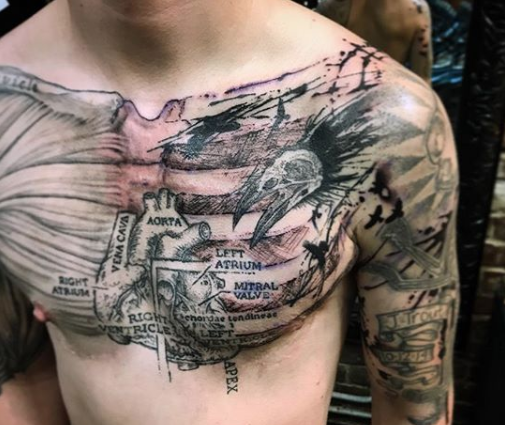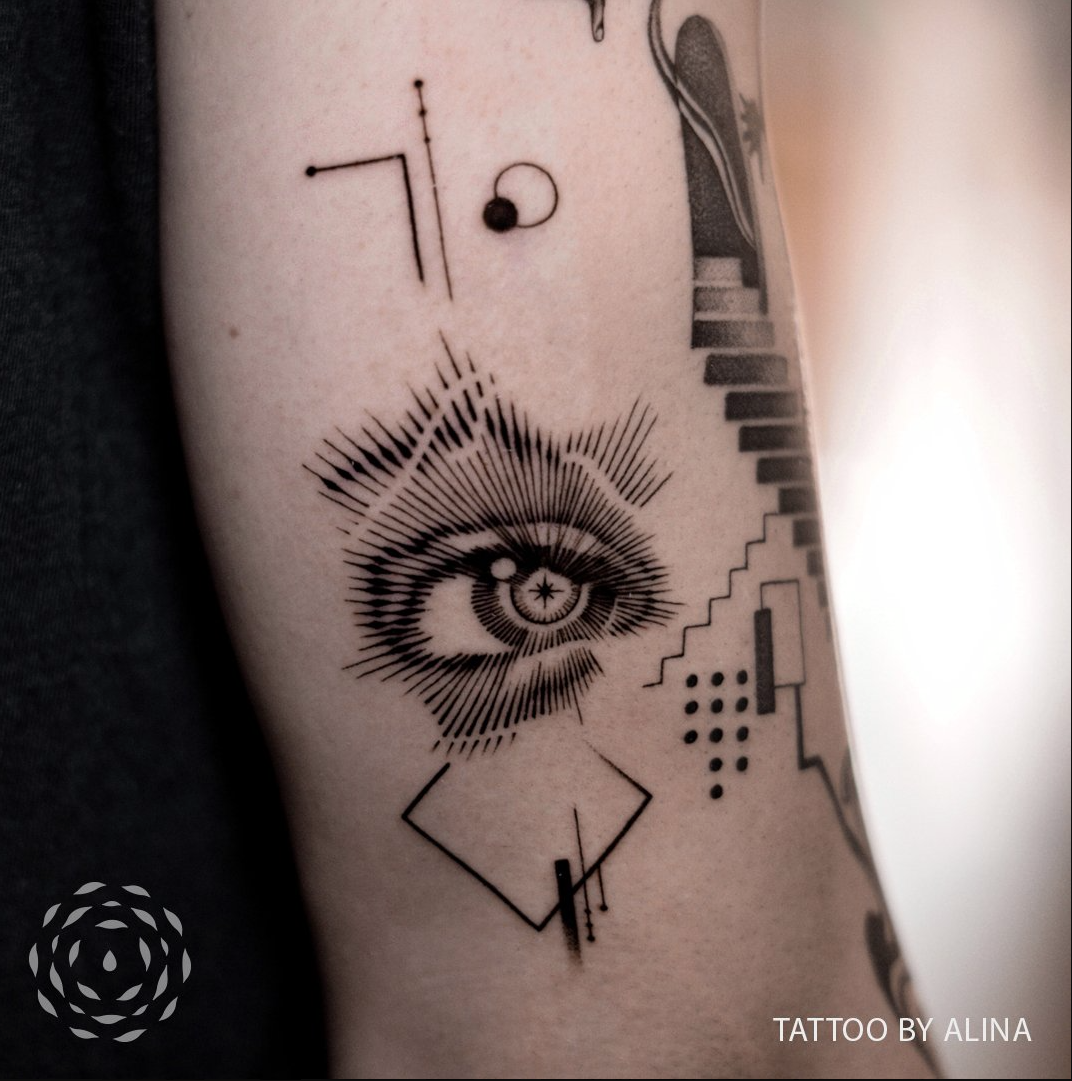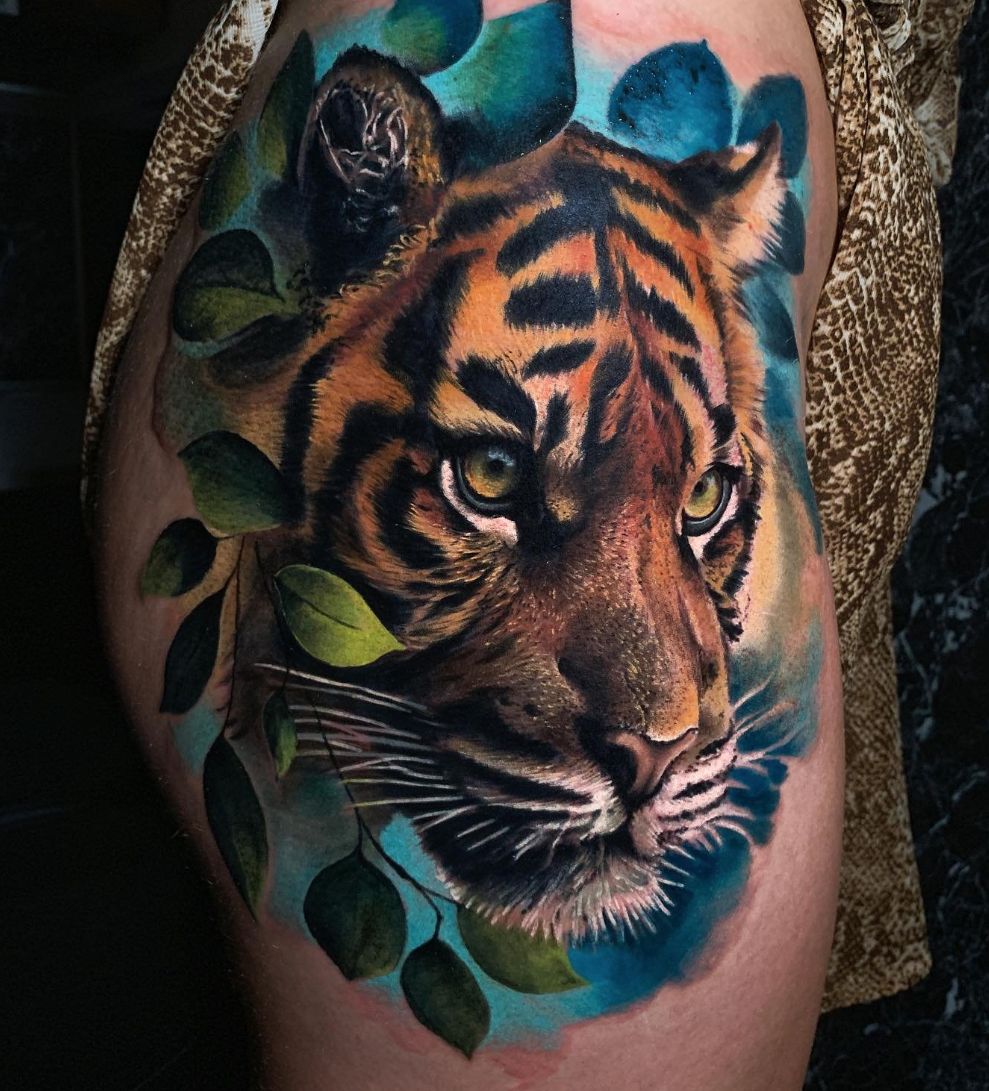Abstract/ Sketch
Traditionally done on paper, this tattoo style appeared more and moreover the last 10 years. These designs look as if they’ve been freehanded roughly on to the skin. In fact, many of the artists that work in this style will draw these designs onto the skin in special markers instead of using stencils. This creates a more organic flow to the design that’s designed to fit the body. This style is all about creativity and freedom of expression often incorporating splashes of colour.
Fun Fact: Many artists have their signature mark that they like including in their work as a way to connect all their pieces. Examples of these would be large red circles, dotted lines and small characters.
Abstract/sketch style tattoo by Helen
Anatomical Tattoo by Milo Marcelo
Anatomical
Before photography was mainstream, surgeons would refer to beautiful drawings of cadavers to better understand how the body worked and operated. You can find the amazing photos in museums, old medical journals and often framed in funky antique stores on Vancouver’s Main street. People love the beauty of these pencil-drawn designs and many have gotten these tattoos on their corresponding body parts to create an x-ray like illusion.
TIP: Studying anatomy? Get one of these tattoos and you may never need to study again. It’s common for people to also include the latin names of each muscle or body part in these tattoos too.
Bio Mechanical
Imagine our bodies operated on pistons, gears and the odd muscle and tissue here and there. Biomechanical tattoos challenge anatomical tattoos by creating a completely sci-fi version on our bodies and how they function. Many biomechanic artists like to create the illusion that the skin is ripped open and its mechanical insides are revealed. Tattoos in this style transform the body into a cross between technology and nature and are a great way to confuse any doctor at first glance.
Fun Fact: It’s said that this style became popular soon after Ridley Scott’s sci-fi thriller Alien hit cinemas in 1979.
Black work / Tribal / Indigenous Body Art
Definitely the oldest form of tattooing that’s still around, dating back thousands of years. It’s important to note that this should be thought of as multiple styles and traditions of tattooing from all over the world.
Tribal:
Tribal tattoo by Angel
Usually identified by a tattoo style popular in the 1990s-2000s. Thick black patterns and designs that had no shading and almost always black. Tribal is a newer term for the ancient art form which can be further described depending on its origins (ie: Haida).
Polynesian Body Art:
Historically practiced on islands like New Zealand, Hawaii and Samoa, tattoos were used to tell the story of a person’s life with geometric symbols and patterns that had specific meanings. These bold designs often covered entire bodies of the eldest members of the family. Every family and community have their own patterns, styles and traditions with these tattoos. Certain tattoo connoisseurs will travel to these communities to experience this sacred and spiritual tattoo process with the traditional tools. Beware, it’s not an easy journey!
Black Work:
Blackwork by Ashley Horncastle
Consider blackwork the evolved, fluid sister to tribal tattoos. She can be just about anything from dark art, illustrative, graphic art, etching or calligraphic scripts. She’s known for her abstract patterns made of shapes and swirls in all black ink and sometimes composed of geometric shapes, figurative forms and recognizable scenes and subjects. It is one of the most experimental styles that is currently dominating the industry. Some artists have been known to black out entire body parts and sometimes adding white highlights to create a uniquely bold style.
Haida & First Nation Art:
It is important for us to specifically honour this tattoo style as it were part of the ceremonies and traditions of the indigenous people. We invite you to visit this link for more information about historical Haida tattoos. (https://www.sfu.ca/brc/online_exhibits/haida_tattoo.html).
Historically, the tattoo markings for Haida first nations represented status, spiritual devotion and decoration. Body art and adornment were a means for individuals to express their identity and spiritual connections.
Haida tattoo by Gig
“The Haida, consists of two main clans or moieties: Eagles and Ravens. Each of these divisions has rights to different crests, which include a number of figures derived from animal and mythological sources. Therefore, particular figures which constitute a family name or connection will be represented in tattooing on a part of the body. The history of how tattoos first came to the Haida is different for both the Eagles and Ravens. In Eagle tradition, it is said that Djila ́qons, the ancestress of the Eagle clan, was the start of all tattooing.
Djila ́qons is described as wearing a hat that is surrounded by frogs and carrying a cane. She is also said to have a painted face and tattoos of laughing geese on her shoulders.”
“It is also believed that when the Low-Ground-People, who are members of the Raven family, raised the Grease-House at Cumshewa was when tattoo marks were first introduced to the Haida. Although this second story is vaguer than the first, each oral history provides a unique insight into the spiritual nature of tattooing.”
Fun Fact: Originally, sharp thorns, fish spines or bones were used for tattooing. Pigments that left a bluish tint on the skin were said to have been made from the charcoal of alder or buckbrush. Black pigment was made of magnetite, gunpowder, India ink or powdered charcoal. Red pigment was said to be made from Chinese vermilion or hematite.
Celtic
Celtic tattoo by Angel
Celtic tattoos have been a common tattoo style amongst the years and their classic designs speak for themselves. Heavy black linework and intertwining details are the main themes of Celtic tattoo work.
History: Some of these designs are very old, dating back several thousand years. It is said that Celtic tattoos were common amongst Celtic warriors, who thought tattoos intimidated enemies during battle. (It is also said that they would fight nearly naked, with brightly spiked hair to further intimidate their enemies!) Ink was made from the dried Woad plant. The dried leaves were boiled multiple times until the liquid became thick and sticky. This thick paste was used with needle-like instruments to put the blue stain underneath the skin.
Dotwork
Dotwork and linework tattoo by Amelia Vogan
Dotwork is not so much of a style but a technique of shading created by using individual tiny dots that form shading. These dots consist of only black or grey ink and can create a really cool sense of movement and depth in a tattoo.
Fun Fact: Similar to the Stick & Poke technique, the artist may choose to use only one needle to apply the ink instead of using a needle grouping in a traditional tattoo machine.
Geometric
Geometric and dotwork tattoo by Ashley Horncastle
Tattoos with geometric designs and symmetrical shapes has been present in many cultural forms of tattooing for centuries (ex: Polynesian and Irezumi) but the modern geometric style is becoming more and more popular. Many of the popular designs (flower of life, golden ration, Metatron's Cube) are spiritual for their wearers as they are connected to patterns found in nature. One thing’s for sure, there’s an intricacy and elegance to these geometric shapes. Clean lines and faultless design are crucial to creating this inking style and done right, many of these tattoos create optical illusions on the skin.
Fun Fact: One of our artists tattooed a scan code on someone and it wasn’t until the very end that we could test it with a cell phone. Turned out, it worked!
Illustrative/Graphic
Illustrative tattoo by Alina
Tattoos have come a long way. There are all forms of people just like there are tattoos, it’s hard to label styles since artists all have their own take on what style of work they create. A large variety of tattoo work these days can be called Illustrative. Lithography, etching and engraving styles could be considered illustrative but so could abstract expressionism, fine line calligraphy and anything involving thinner outlines.... essentially illustrative tattoos could be a line-drawing you find in a sketch-book.
Fun Fact: The internet says...”The distinction lies in the fact that art is the idea (brought to life) while an illustration is a depiction (or explanation) of an idea. Fine Art is simply art for art's sake. Even if you are doing a commission for a client, it would still be fine art. But illustration is illustrating a story or idea.”
Irezumi (Japanese traditional)
Irezumi tattoo by Angel
This is a very recognizable tattoo style that’s become more and more popular in today’s western pop culture. These pieces are often very large covering entire body parts or a full body and depicting a mythological creature or story. These pieces are often rich in colourful detail. Out of respect for the history of these tattoos, there are rules that traditional Japanese tattoo artists follow; Depictions of Buddha above the waist only (below would be disrespectful) and pairing certain animals with certain flowers are some examples of these rules.
Fun Fact: Japanese have been getting “inked” since 10,000 BC, but the traditional Irezumi style, as it is known today, developed around the Yayoi period (300 BC -300 AD). Tattoos in Japan are still a bit taboo, as they are often associated with the Yakuza (Japan’s dangerous mafia).
Lettering / Script
Words, Family names, Chinese characters and Sanskrit are all examples of lettering and script tattoos. We always ask that you provide us with the words and script style for these tattoos since there are millions of ways to write a word.
Lettering by Amelia Vogan
Check out www.dafont.com for great script examples. Just make sure you pick something that is clear and easy to read since over time, as the ink blurs naturally, you’ll still want to be able to read it. Some artists will custom design the script tattoo especially if you want a larger piece. Keep in mind foreign letters might change their meaning when altered into a design, do your research and ask someone who speaks the language to confirm the word still represents what you want it to be.
Not So Fun Fact: Spelling and meaning mistakes are unfortunately common for these tattoos. It’s your responsibility to always double, triple, quadruple check the meaning behind your script tattoo since it’s not the artist’s responsibility.
Linework/Minimalism
Linework/minimalism tattoo by Alina
Linework can be just about anything involving primarily lines. This style often refers to a tattoo that doesn’t have much shading or colouring. We get a lot of request for fine line tattoos because they have become more and more popular over the last couple of years... especially on Instagram. Instagram can be misleading and though many people see these and request single needle tattoos, our artists often suggest to get a slightly thicker line by using 3-5 needle grouping needle. This helps maintain the line’s structure and often prevents premature fading. A slightly thicker line will help the tattoo look crisp and keep its shape over time.
Micro-realism
Micro-realism tattoo by Alina
Micro-realistic tattoo -A style of tattooing that uses gradual, multi-layered application with a fine needle to achieve gradient control with a photographic level of detail. The tattoos are usually smaller in size and with great realistic detail.
In addition, micro-realistic tattoos often require more time than others with less detail. While all other tattoos use crisp black outlines, micro-realistic tattoos use gradual shading and layering to create three-dimensional effects that stand out. This type of less defined outline helps to increase the sense of three-dimensionality.
(American) Traditional / Oldschool
American Traditional generally follows a strict set of design rules. Examples of these are bold colour palette (mostly just red, green, yellow, brown, black and blue colours), thick black outlines, two-dimensional designs and crisp images with minimal shading. Think grandpa’s navy tattoo, Sailor Jerrys Rum, Ed Hardy sweaters (minus the bling) and that photo of the really badass woman you saw in our shop’s bathroom.
Traditional tattoo by Aly Brooke
The famous tattoos in this style are anchors, daggers, sparrows, tigers, pin-up girls and eagles. However, this is a style of tattooing that dominated the tattoo industry years ago when flash sheets were the main way to get tattooed, with custom tattoos being the “new” thing, you can get anything tattooed in this style and if you like bold colours and big outlines.
The more you veer off these traditional designs, the more chances you’ll enter into the next tattoo style on our list, “neo traditional” tattoos.
Fun fact: Many of the old school tattoos originated from sailors and their beliefs. Here’s one about Pigs and Roosters: These animals were usually tattooed on the feet or behind the ankles of a sailor. They traditionally symbolized survival from a shipwreck, and superstitious sailors also believed that they were symbols of protection from drowning. This belief originated from the fact that both animals were often kept in wooden crates on board, and, when a ship capsized, these crates would most likely get washed up to shore.
Neo-Traditional
Neo-traditional tattoo by Helen
Neo-traditional artwork stays true in many ways to American Traditional. It features bold black lines as well as a saturated bold colour palette. However, these tattoo designs also often feature three-dimensional images and an illustrative style to them. It’s not uncommon to play with line thickness throughout the piece creating more of a movement and organic shade to the tattoo.
Fun fact: Many Neo-traditional artists are influenced by Art Nouveau and Art Deco aesthetics. Pieces done in this style are known for their lush, decorative details as well as the use of natural imagery such as florals and animals.
New School
New School tattoo by Ashley Horncastle
If old school is the grandfather of tattoos, then new school is the rebellious wild teenager. Depending on who you ask, this modern tattooing style started up between the 70s, ‘80s and/or ‘90s. You’ll still find heavy outlines in these pieces these tattoos are often packed with vibrant, in-your-face colours and are not limited to the themes of traditional tattoos. This fun tattoo style often features cartoons or graffiti-like designs, with exaggerated proportions and storybook-like characters.
Fun Fact: It is said that due to this newly emerged style, tattoo artists started sharing their techniques with one another which played a major part of promoting the progression of tattooing.
Ornamental
Ornamental tattoo by Alina
Ornamental tattoo designs tend to be freestyle decorative pieces involving flowing patters, lines, mandalas, spirals, and repetitive motifs.
Placement is key when designing a mandala or basic floral piece, when done right the results can be downright sublime. We can find ornamentation in fabrics or clothing, some decorated with embroidery or appliqués. Even in music this term is used to designate arrangements in harmonies and add a certain "colour" to compositions.
Ornamental tattoos correspond to a style of designs with geometric, abstract and symmetrical figures and can be mixed with very varied styles and techniques.
Realistic / Realism (Black & Grey + Colour)
Black and grey realism by Ania Ray
The name says it all; think of a photograph on your skin. Many artists will use white highlights to create the illusion of light and texture, but usually, there are minimal black outlines in realistic tattoos. Though classic realism has been a part of fine art for centuries, it has only become popular in the tattoo world in the last 15 years. This style has become increasingly refined with new tattoo techniques and equipment making it one of the most popular tattoo styles these days.
Realistic tattoo by Adrian Cier
Fun Fact: Unlike the new-school or illustrative style, realism focuses primarily on transferring a real image onto the skin as accurately as possible. Many artists use photographs to create these tattoo designs by making a collage of different images.
Don’t be surprised if you receive a collage as your tattoo drawing, it will come together on the day of the appointment through drawn on mapping and stencilling.
Trash Polka / Paint Brush Stroke
Using primarily large blocks of red and black ink, Trash Polka usually incorporates design elements that vary from surreal and abstract to geometric and traditional. Paintbrush strokes and large bold designs are often seen in these tattoos. Script isn’t uncommon to see either.
Trash polka tattoo by Milo Marcelo
Fun Fact: Originating in Europe trash polka is a painterly tattoo style created by Simone Plaff and Volko Merschky in Germany. Volko describes it as a combination of “realism and trash; the nature and the abstract; technology and humanity; past, present, and future. Opposites that they are trying to urge into a creative dance to harmony and rhythm in tune with the body.”
Watercolour
Watercolour tattoo by Justina Kervel
In extremely high demand and seen daily in our studio, watercolour is easily one of the newest tattoo styles that have emerged into the tattoo scene over the last 5 years. Classically done on paper with the use of brushes, pigment and water to create fluid colourful borderless designs, tattooing in this style is a completely different approach. Ink is introduced into the skin like any other tattoo with a repetitive series of dots. Artists who tattoo in this style end up with a finished product that looks more like a painting that they created with a brush than a tattoo done with a needle.
Thanks for reading!
Check out our artist's portfolios to discover their own unique styles!
www.liquidambertattoo.com/artists
Interested in a tattoo style that is not listed here?
Inquire via the tattoo request form and be as detailed as possible so that we know what you have in mind.





















